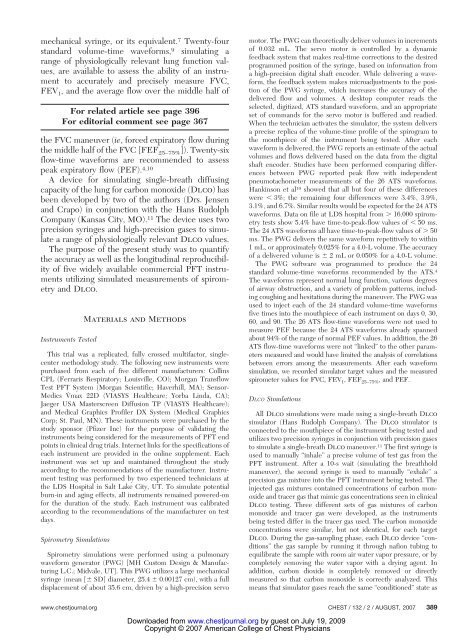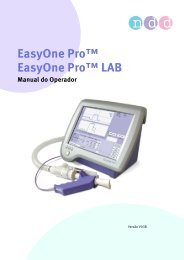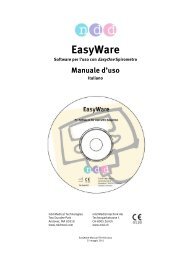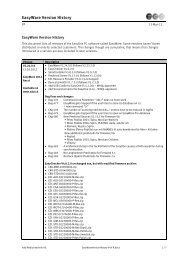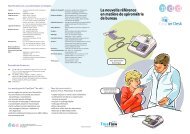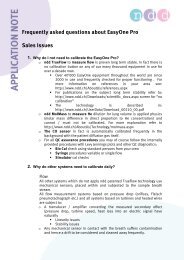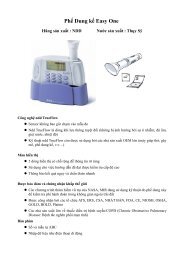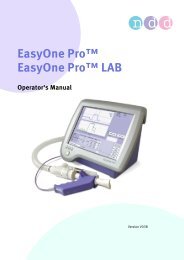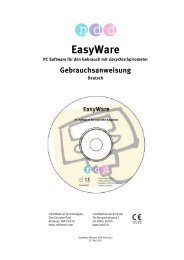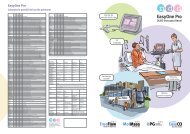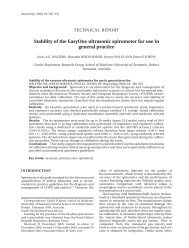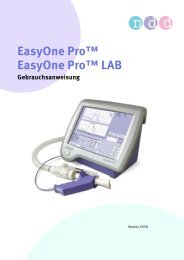Measurements of Pulmonary Function Instrument Accuracy - ndd.ch
Measurements of Pulmonary Function Instrument Accuracy - ndd.ch
Measurements of Pulmonary Function Instrument Accuracy - ndd.ch
Create successful ePaper yourself
Turn your PDF publications into a flip-book with our unique Google optimized e-Paper software.
me<strong>ch</strong>anical syringe, or its equivalent. 7 Twenty-four<br />
standard volume-time waveforms, 9 simulating a<br />
range <strong>of</strong> physiologically relevant lung function values,<br />
are available to assess the ability <strong>of</strong> an instrument<br />
to accurately and precisely measure FVC,<br />
FEV 1, and the average flow over the middle half <strong>of</strong><br />
For related article see page 396<br />
For editorial comment see page 367<br />
the FVC maneuver (ie, forced expiratory flow during<br />
the middle half <strong>of</strong> the FVC [FEF 25–75%]). Twenty-six<br />
flow-time waveforms are recommended to assess<br />
peak expiratory flow (PEF). 4,10<br />
A device for simulating single-breath diffusing<br />
capacity <strong>of</strong> the lung for carbon monoxide (Dlco) has<br />
been developed by two <strong>of</strong> the authors (Drs. Jensen<br />
and Crapo) in conjunction with the Hans Rudolph<br />
Company (Kansas City, MO). 11 The device uses two<br />
precision syringes and high-precision gases to simulate<br />
a range <strong>of</strong> physiologically relevant Dlco values.<br />
The purpose <strong>of</strong> the present study was to quantify<br />
the accuracy as well as the longitudinal reproducibility<br />
<strong>of</strong> five widely available commercial PFT instruments<br />
utilizing simulated measurements <strong>of</strong> spirometry<br />
and Dlco.<br />
<strong>Instrument</strong>s Tested<br />
Materials and Methods<br />
This trial was a replicated, fully crossed multifactor, singlecenter<br />
methodology study. The following new instruments were<br />
pur<strong>ch</strong>ased from ea<strong>ch</strong> <strong>of</strong> five different manufacturers: Collins<br />
CPL (Ferraris Respiratory; Louisville, CO); Morgan Transflow<br />
Test PFT System (Morgan Scientific; Haverhill, MA); Sensor-<br />
Medics V˙ max 22D (VIASYS Healthcare; Yorba Linda, CA);<br />
Jaeger USA Masterscreen Diffusion TP (VIASYS Healthcare);<br />
and Medical Graphics Pr<strong>of</strong>iler DX System (Medical Graphics<br />
Corp; St. Paul, MN). These instruments were pur<strong>ch</strong>ased by the<br />
study sponsor (Pfizer Inc) for the purpose <strong>of</strong> validating the<br />
instruments being considered for the measurements <strong>of</strong> PFT end<br />
points in clinical drug trials. Internet links for the specifications <strong>of</strong><br />
ea<strong>ch</strong> instrument are provided in the online supplement. Ea<strong>ch</strong><br />
instrument was set up and maintained throughout the study<br />
according to the recommendations <strong>of</strong> the manufacturer. <strong>Instrument</strong><br />
testing was performed by two experienced te<strong>ch</strong>nicians at<br />
the LDS Hospital in Salt Lake City, UT. To simulate potential<br />
burn-in and aging effects, all instruments remained powered-on<br />
for the duration <strong>of</strong> the study. Ea<strong>ch</strong> instrument was calibrated<br />
according to the recommendations <strong>of</strong> the manufacturer on test<br />
days.<br />
Spirometry Simulations<br />
Spirometry simulations were performed using a pulmonary<br />
waveform generator (PWG) [MH Custom Design & Manufacturing<br />
L.C.; Midvale, UT]. This PWG utilizes a large me<strong>ch</strong>anical<br />
syringe (mean [� SD] diameter, 25.4 � 0.00127 cm), with a full<br />
displacement <strong>of</strong> about 35.6 cm, driven by a high-precision servo<br />
motor. The PWG can theoretically deliver volumes in increments<br />
<strong>of</strong> 0.032 mL. The servo motor is controlled by a dynamic<br />
feedback system that makes real-time corrections to the desired<br />
programmed position <strong>of</strong> the syringe, based on information from<br />
a high-precision digital shaft encoder. While delivering a waveform,<br />
the feedback system makes microadjustments to the position<br />
<strong>of</strong> the PWG syringe, whi<strong>ch</strong> increases the accuracy <strong>of</strong> the<br />
delivered flow and volumes. A desktop computer reads the<br />
selected, digitized, ATS standard waveform, and an appropriate<br />
set <strong>of</strong> commands for the servo motor is buffered and readied.<br />
When the te<strong>ch</strong>nician activates the simulator, the system delivers<br />
a precise replica <strong>of</strong> the volume-time pr<strong>of</strong>ile <strong>of</strong> the spirogram to<br />
the mouthpiece <strong>of</strong> the instrument being tested. After ea<strong>ch</strong><br />
waveform is delivered, the PWG reports an estimate <strong>of</strong> the actual<br />
volumes and flows delivered based on the data from the digital<br />
shaft encoder. Studies have been performed comparing differences<br />
between PWG reported peak flow with independent<br />
pneumota<strong>ch</strong>ometer measurements <strong>of</strong> the 26 ATS waveforms.<br />
Hankinson et al 10 showed that all but four <strong>of</strong> these differences<br />
were � 3%; the remaining four differences were 3.4%, 3.9%,<br />
3.1%, and 6.7%. Similar results would be expected for the 24 ATS<br />
waveforms. Data on file at LDS hospital from � 16,000 spirometry<br />
tests show 5.4% have time-to-peak-flow values <strong>of</strong> � 50 ms.<br />
The 24 ATS waveforms all have time-to-peak-flow values <strong>of</strong> � 50<br />
ms. The PWG delivers the same waveform repetitively to within<br />
1 mL, or approximately 0.025% for a 4.0-L volume. The accuracy<br />
<strong>of</strong> a delivered volume is � 2 mL or 0.050% for a 4.0-L volume.<br />
The PWG s<strong>of</strong>tware was programmed to produce the 24<br />
standard volume-time waveforms recommended by the ATS. 4<br />
The waveforms represent normal lung function, various degrees<br />
<strong>of</strong> airway obstruction, and a variety <strong>of</strong> problem patterns, including<br />
coughing and hesitations during the maneuver. The PWG was<br />
used to inject ea<strong>ch</strong> <strong>of</strong> the 24 standard volume-time waveforms<br />
five times into the mouthpiece <strong>of</strong> ea<strong>ch</strong> instrument on days 0, 30,<br />
60, and 90. The 26 ATS flow-time waveforms were not used to<br />
measure PEF because the 24 ATS waveforms already spanned<br />
about 94% <strong>of</strong> the range <strong>of</strong> normal PEF values. In addition, the 26<br />
ATS flow-time waveforms were not “linked” to the other parameters<br />
measured and would have limited the analysis <strong>of</strong> correlations<br />
between errors among the measurements. After ea<strong>ch</strong> waveform<br />
simulation, we recorded simulator target values and the measured<br />
spirometer values for FVC, FEV 1, FEF 25–75%, and PEF.<br />
DLCO Simulations<br />
All Dlco simulations were made using a single-breath Dlco<br />
simulator (Hans Rudolph Company). The Dlco simulator is<br />
connected to the mouthpiece <strong>of</strong> the instrument being tested and<br />
utilizes two precision syringes in conjunction with precision gases<br />
to simulate a single-breath Dlco maneuver. 11 The first syringe is<br />
used to manually “inhale” a precise volume <strong>of</strong> test gas from the<br />
PFT instrument. After a 10-s wait (simulating the breathhold<br />
maneuver), the second syringe is used to manually “exhale” a<br />
precision gas mixture into the PFT instrument being tested. The<br />
injected gas mixtures contained concentrations <strong>of</strong> carbon monoxide<br />
and tracer gas that mimic gas concentrations seen in clinical<br />
Dlco testing. Three different sets <strong>of</strong> gas mixtures <strong>of</strong> carbon<br />
monoxide and tracer gas were developed, as the instruments<br />
being tested differ in the tracer gas used. The carbon monoxide<br />
concentrations were similar, but not identical, for ea<strong>ch</strong> target<br />
Dlco. During the gas-sampling phase, ea<strong>ch</strong> Dlco device “conditions”<br />
the gas sample by running it through nafion tubing to<br />
equilibrate the sample with room air water vapor pressure, or by<br />
completely removing the water vapor with a drying agent. In<br />
addition, carbon dioxide is completely removed or directly<br />
measured so that carbon monoxide is correctly analyzed. This<br />
means that simulator gases rea<strong>ch</strong> the same “conditioned” state as<br />
www.<strong>ch</strong>estjournal.org CHEST / 132 /2/AUGUST, 2007 389<br />
Downloaded from<br />
www.<strong>ch</strong>estjournal.org by guest on July 19, 2009<br />
Copyright © 2007 American College <strong>of</strong> Chest Physicians


